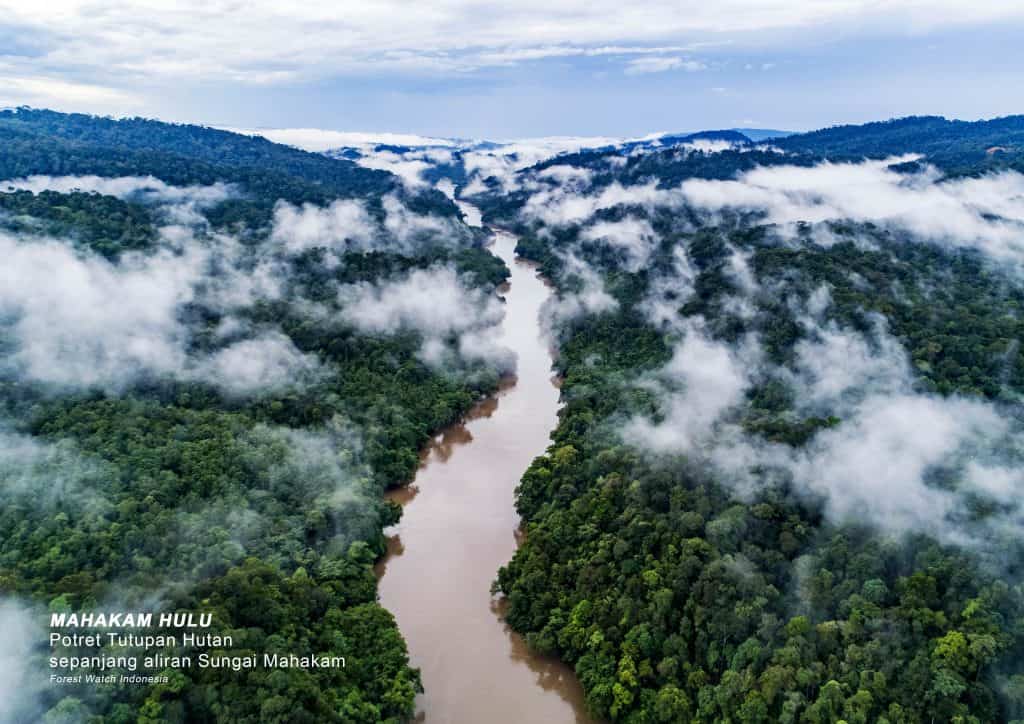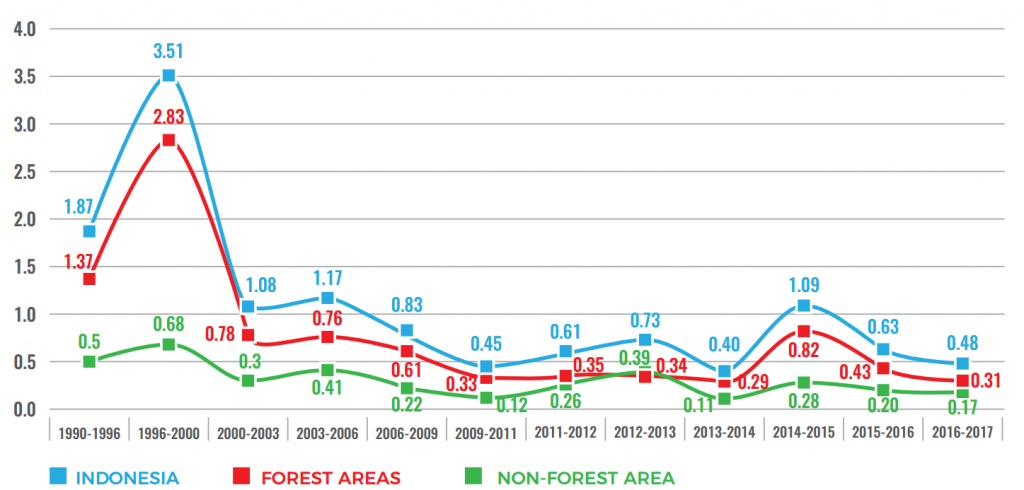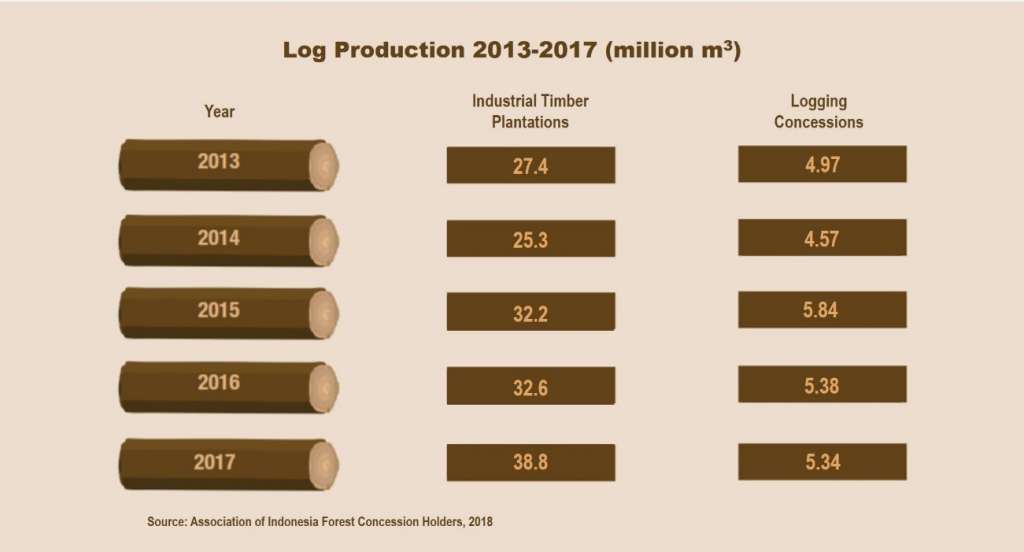
Deforestation may be literally defined as loss of forest. Thus, it is imperative to clarify the definition of forest as the basis for understanding deforestation. In the Forestry Law, it is stated that forest is a blessing of the almighty God for the nation of Indonesia. It is an invaluable gift, for forests generate and grow naturally in Indonesian soil without requiring planting or cultivation by humans. Furthermore, article 1 paragraph 2 in Law No. 41 of 1999 stipulates that “forest is a unit of ecosystem in the form of lands comprising biological resources, dominated by trees in an association with its natural environment, which cannot be separated from one another.” Therefore, defining forests should involve not only describing them as a cluster of trees, but instead include their roles and functions as an element of a life support system, even as living space for all beings, including humans.
With global climate change issues, Indonesia ratified the United Nation Framework Convention on Climate Change (UNFCCC) through Law No. 6 of 1994. Afforestation and reforestation contribute to carbon dioxide sequestration to reduce greenhouse gas (GHG) effect through the Clean Development Mechanism (CDM). In Regulation of Minister of Forestry No. 14 of 2004 on Afforestation and Reforestation in the CDM Framework, forest is defined as a land covering at least 0.25 ha and grown with trees with at least 30% canopy cover and final growth reaching at least 5 m in height. This is technically is a more operational definition for identifying forest cover and calculating carbon stock, carbon sequestration, as well as carbon emission, even for a large-scale using remote sensing techniques.
The Government of Indonesia currently refers to a definition for deforestation from Regulation of Minister of Environment and Forestry No. 70 of 2017 concerning Procedures for Reducing Emissions from Deforestation and Forest Degradation, Role of Conservation, Sustainable Management of Forest and Enhancement of Forest Carbon Stocks. In this regulation, deforestation is defined as permanent change from a forested to non-forested area, and is then further classified into gross deforestation and net deforestation. Gross deforestation is a permanent change of natural forest cover without calculating for regrowth or developing forest plantations. Meanwhile net forest cover is defined as a permanent change of natural forest cover by considering regrowth and/or developing forest plantations. In addition, forest degradation is defined as reduced quantity in forest cover and carbon stock over a certain period.
The definitions of forest and deforestation in both Regulations of Ministers in forestry are highly relevant when looking at forests and their changes as part of emission reduction. This is explicitly stated in the dictum considering Regulation of Minister of Environment and Forestry No. 70 of 2017, that national GHG emission reduction target of 26% (unconditional) to 41% (conditional) compared to Business as Usual scenario by 2030 is to be implemented through mitigation efforts such as in Land Use, Land Use Change and Forestry sector. Mitigation actions in the forestry sector is done by reducing emissions from deforestation and forest degradation, forest carbon stock conservation, sustainable forest management, and increasing forest carbon stock.
What are the Government’s Official Deforestation Figures?
Indonesia’s forest deforestation rate in 1985-1998 was no less than 1.6-1.8 million ha per year (Forestry and Estates Agency, 2000). In 2000, deforestation rate increased to at least 2 million ha per year (FWI/GFW, 2001). According to the Indonesian Ministry of Environment and Forestry (MoEF), deforestations has declined through the Reformation Era to date, with rate of 0.48 million ha in 2016-2017.
In the recent years, MoEF updated its data and published annual deforestation figures with the definition of deforestation as stipulated in Regulation of Minister of Environment and Forestry No. 70 of 2017. Official figures state that deforestation rates declined to 0.73 million ha per year (2013-2014), then rose to 1.09 million ha per year (2014-2015), then dipped to 0.63 million ha per year (2015-2016), and further decreased to 0.48 million ha per year (2016-2017) (Fig. 1).

Figure 1. Deforestation figures according to MoEF
Using the same data, FWI then further investigated to find out how deforestation, gross deforestation, and net deforestation definitions functionally operate.
Table 1. Gross and Net Deforestation in 2013-2017 According to MoEF
| Gross Deforestation | 2013-2014 (thousand ha) | % | 2014-2015 (thousand ha) | % | 2015-2016 (thousand ha) | % | 2016-2017 (thousand ha) | % |
| Primary Forest | 331.8 | 58% | 749.9 | 61% | 776.5 | 95% | 632.9 | 95% |
| Forest Plantation | 236.3 | 42% | 473.6 | 39% | 43.2 | 5% | 30.5 | 5% |
| Sub total | 568.1 | 100% | 1.223.5 | 100% | 819.7 | 100% | 663.4 | 100% |
| Reforestation | ||||||||
| Secondary Forest | 2.8 | 2% | 8.7 | 7% | 127.4 | 67% | 142.9 | 78% |
| Forest Plantation | 167.8 | 98% | 122.6 | 93% | 63.2 | 33% | 40.5 | 22% |
| Sub total | 170.6 | 100% | 131.3 | 100% | 190.6 | 100% | 183.4 | 100% |
| Net Deforestation | 397.5 | 1092.2 | 629.1 | 480.0 |

Figure 2. Comparison between deforestation and reforestation in natural and plantation forests
These data show how natural forest cover change occurs. As we know, deforestation trends collectively declined in 2015-2017 (Fig. 2), but deforestation in natural forests tend to increase in 2013-2017 (Fig. 2), although reforestation (representing regrowth in the deforestation definition) in 2015-2017 also increased for natural forests (Fig. 2, diagram on the right).
For cover change in plantation forests, deforestation as well as reforestation trends continued to decline during 2013 to 2017 (Fig. 3).

Figure 3. Forest cover change in plantation forests
As shows in the figures above, the gap between deforestation and reforestation in plantations forests in 2013-2017 is relatively large every year. Between the periods of 2014-2015 and 2015-2016, deforestation dropped from 473.6 thousand ha to 43.2 thousand ha. The similar occurred with reforestation, from 122.6 thousand ha to 63.2 thousand ha. Separately, deforestation and reforestation figures in plantation forests are linked to business processes in these plantation forests. Deforestation processes in plantation forests may be assumed to be the harvest processes, while reforestation in plantation forests may be assumed as the planting process. Both are parts of the silviculture system that may indicate the performance of plantation forest development.
Compared to log production data in industrial timber plantations, in 2013 to 2017 (Fig. 4) volumes for the past two years show an increase. Plantation forest comprises stands of uniform age and species with relatively similar growth rates, and therefore the areas required to produce these figures will be similar also. Looking at the cover change data from plantation forests, with their significant gaps, leads to questions about the accuracy of the MoEF published land cover data.

Figure 4. Log production in 2013 to 2017
Critical Note on the Government Version of Deforestation Data
The definition of deforestation applied by the government aims to be the foundation for information in climate change policies. The carbon calculation mechanisms implemented in the definitions of forest and its changes have directly reduced the definition stipulated in the Forestry Law. This is indicated by the collective decline in deforestation figures, though from a different vantage point, the same data shows that natural forest deforestation in Indonesia has in fact increased.
Differences in forest cover and land, with the assumption that timber production data from industrial timber plantations, indicates inconsistencies. On the other hand, land cover data published by MoEF cannot be publicly verified for its accountability because the spatial land cover data is not part of public information based on Circulation of Minister of Environment and Forestry SE.4/Menlhk/PKTL/KUM.1/11/2016 on Sharing of Environment and Forestry Data and Spatial Information.
Information disclosure must be implemented absolutely, so that information on forest and forest cover change is not dominated by government claims.
Source of box: FWI.Potret Keadaan Hutan Indonesia, 2013-2017.2019



